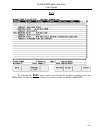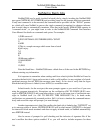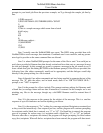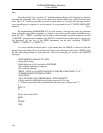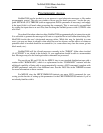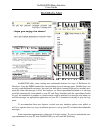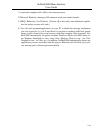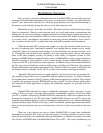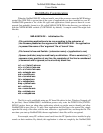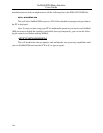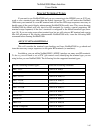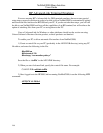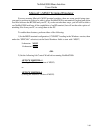
NetMail/3000 Menu Interface
Users Guide
2-93
MultiMedia Operation
Once you have set up the multimedia functions in NetMail/3000, you are ready to process
messages with multimedia attachments. Of course, you might just be asking, “just what IS multi-
media?” and “what would I use that for?” Both are good questions, and a good understanding of
the answers could radically change the way you work with electronic mail.
Multimedia means “more than one media.” Electronic mail has traditionally been written
letters (or characters). When you sent electronic mail, you could send written correspondence but
nothing else. In recent years though, computer hardware and software have brought new means of
communicating ideas and information. Most of us have seen modern PCs display dazzling graph-
ics in many colors, spreadsheets, and perhaps even moving pictures (animation). Even sound is
now a common feature on PCs, as units often come with built in speakers and microphones.
While the idea that a PC could present graphics or even play recorded sound are not new,
the idea of capturing those “multimedia segments” and sending them to another user by simply
“attaching” them to an electronic mail message is an idea which has only recently become a real-
ity. Through the new electronic mail standards, now such segments can be sent not only among
users of the same computer systems, but among a wide variety of disparate systems (in fact,
among any MIME Standard compatible mail systems). NetMail/3000 is such a system, and allows
both the attaching of such segments as well as their display (though NetMail/3000 depends on
software on the PC to actually process the segments). In addition, many of the standard multime-
dia file types can be handled by software which comes with Microsoft Windows. For example,
Windows Paintbrush can handle some graphics files, Windows Write can process .WRI files, and
the Sound recorder can handle .WAV files if you don’t have another sound player installed.
“Standard” HP terminals have no sound capability, and most in fact have no graphical dis-
play capability (those that do aren’t compatible with any standards anyway). To process multime-
dia segments then, features of the PC running an HP terminal emulator are utilized. The software
to transfer the segments from the HP3000 mail system to the PC and the software which selects
and launches PC-based applications to display the multimedia segments are provided with Net-
Mail/3000.
NetMail/3000 automatically detects multimedia attachments within messages in your
mailbox. When you read a message which contains a multimedia segment (at least one which
your PC is capable of displaying) NetMail/3000 will automatically extract the segment from the
message and transmit it to your PC. Once there, NetMail/3000 software on your PC looks up the
application that handles that type of file and launches the application for you, with the multimedia
segment already loaded. The list of file types your PC can handle, and the applications that handle
them can be customized by the user, and instructions on how to do this are described in the next
section.
There are a few options you can set within NetMail/3000 to control how multimedia
attachments are handled. First of all, you have the option of selecting whether you want to auto-
matically download and view multimedia message attachments, or whether you prefer to be asked
first. Set the AUTOMM value in NetMail/3000 either ON or OFF -- ON causes attachments to be



